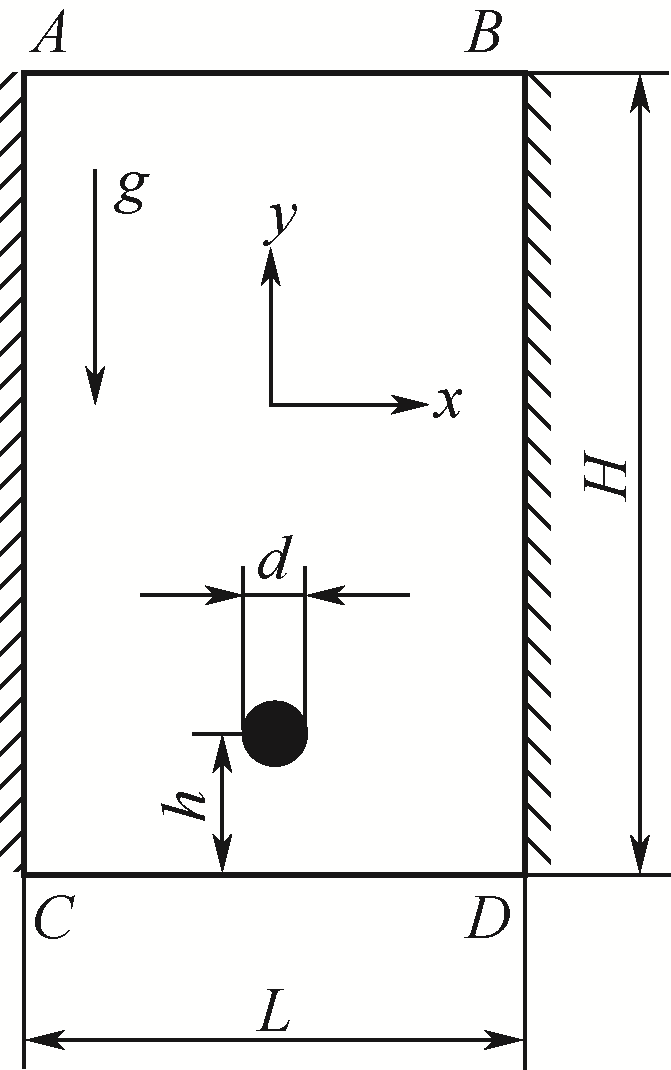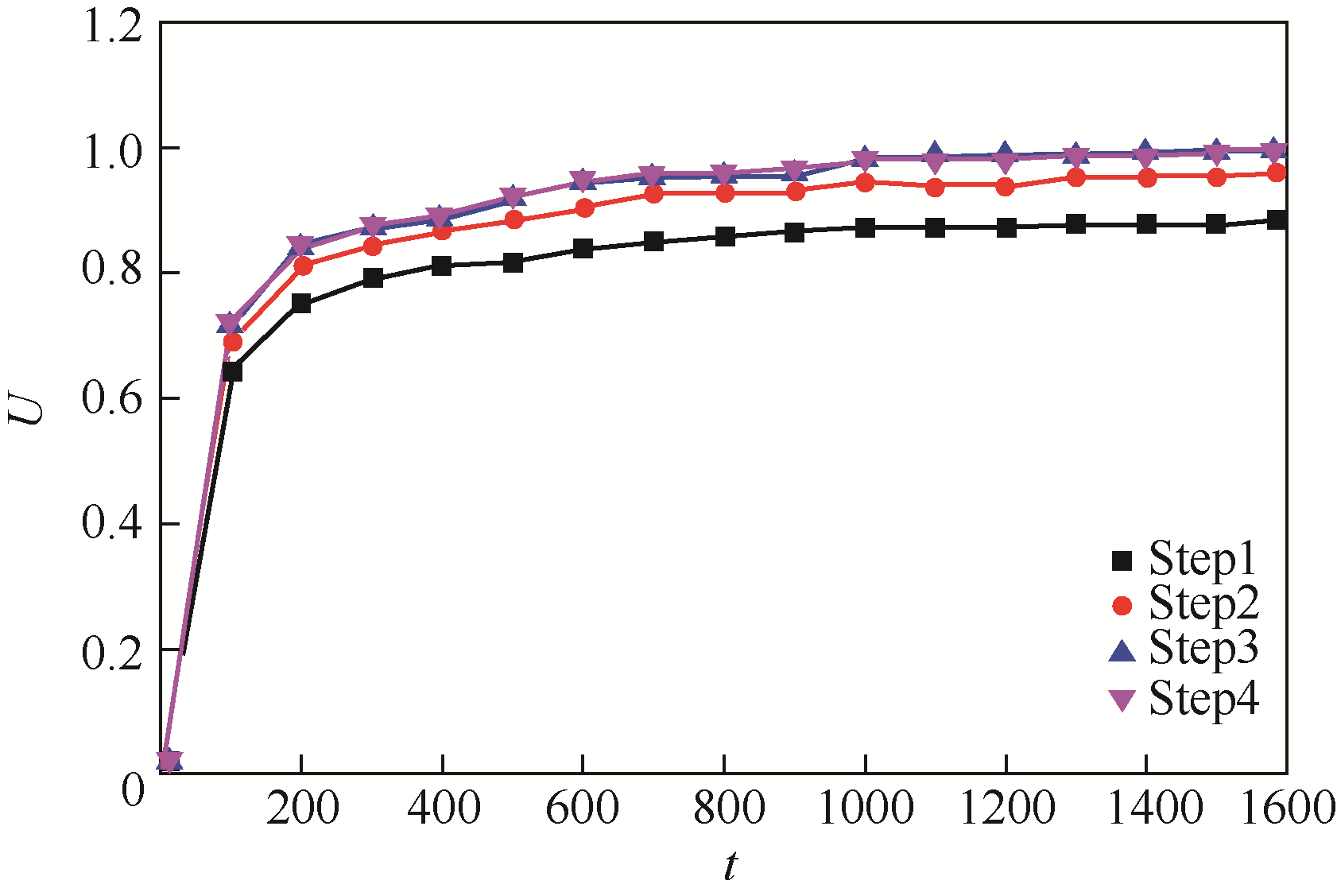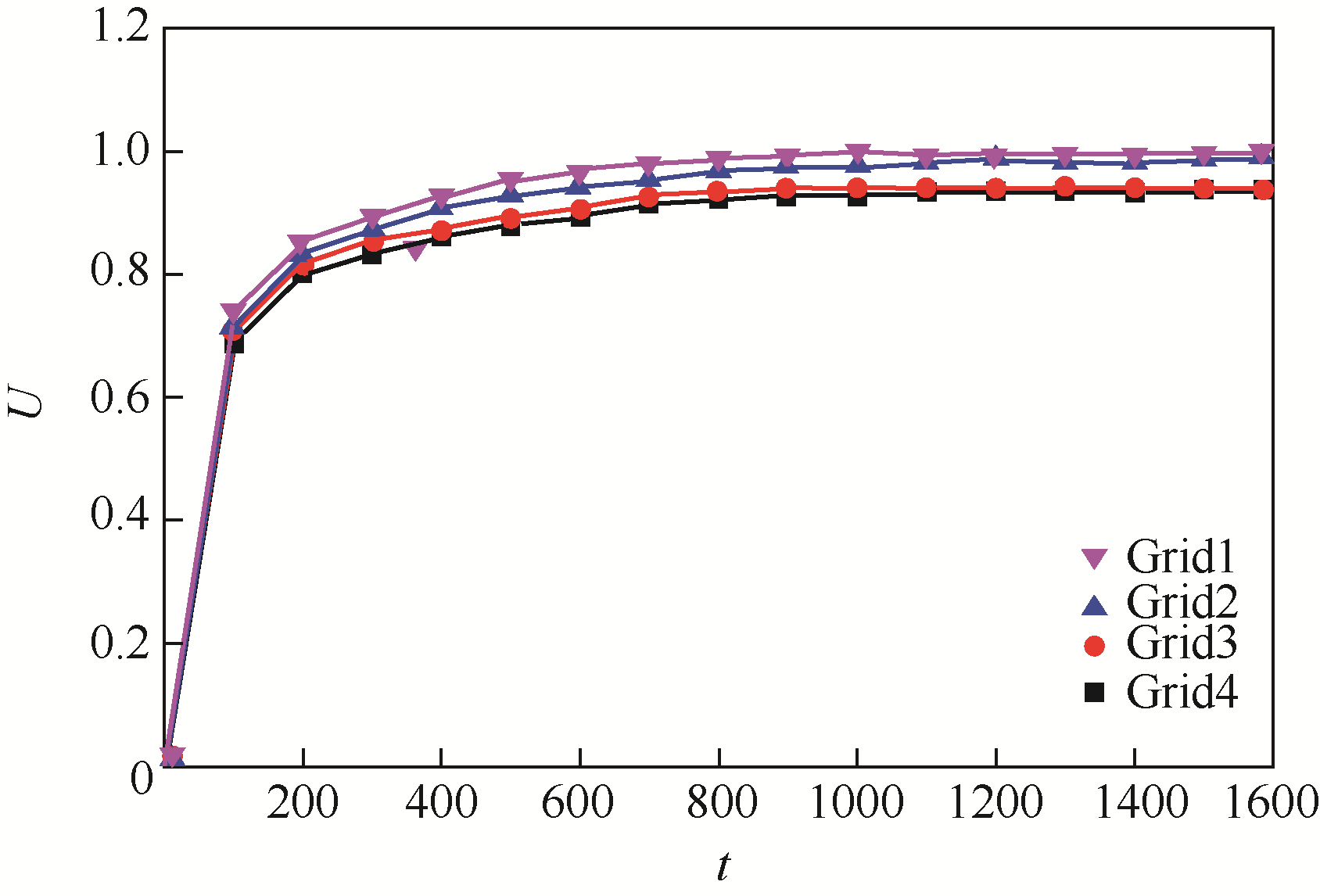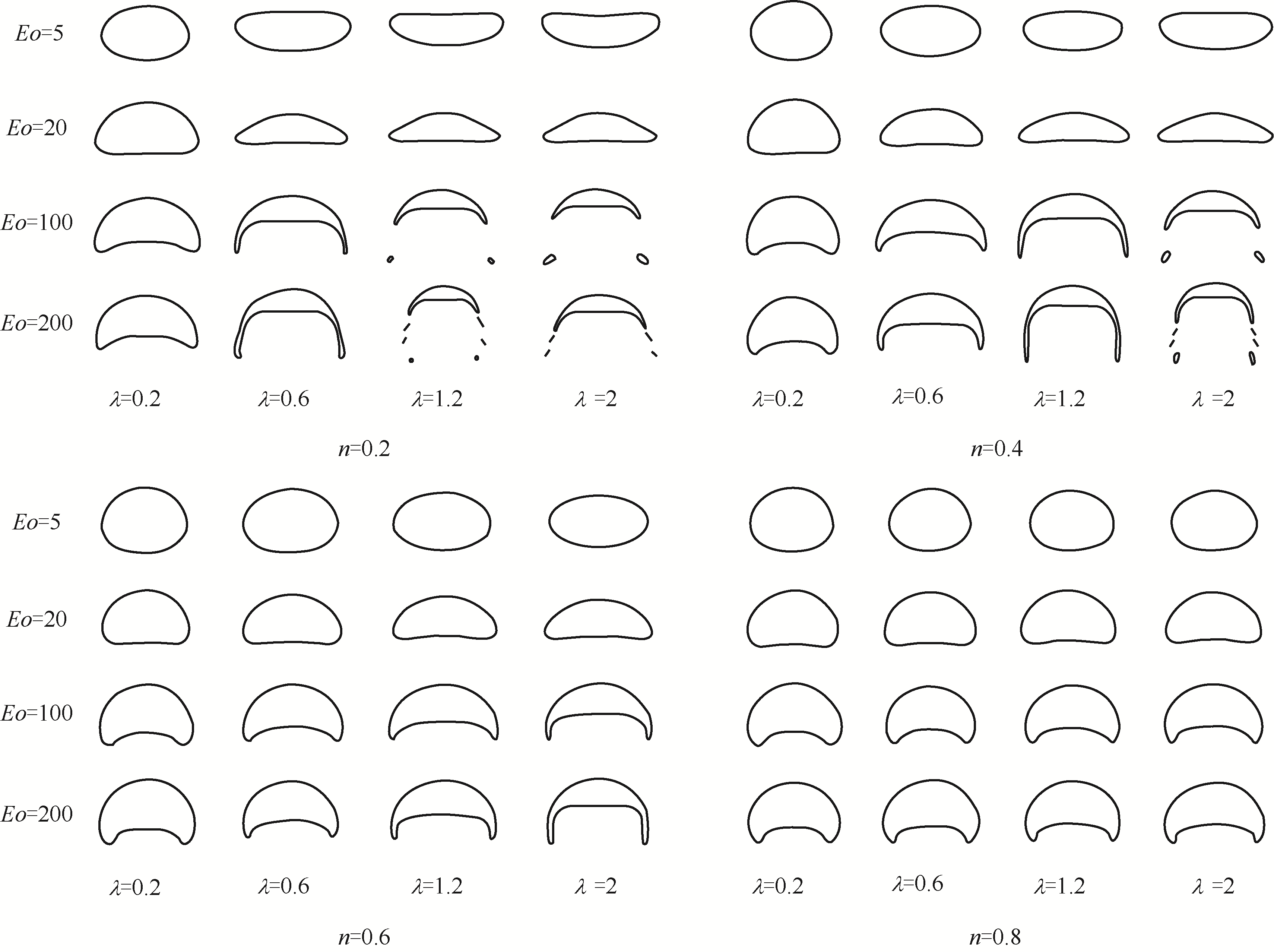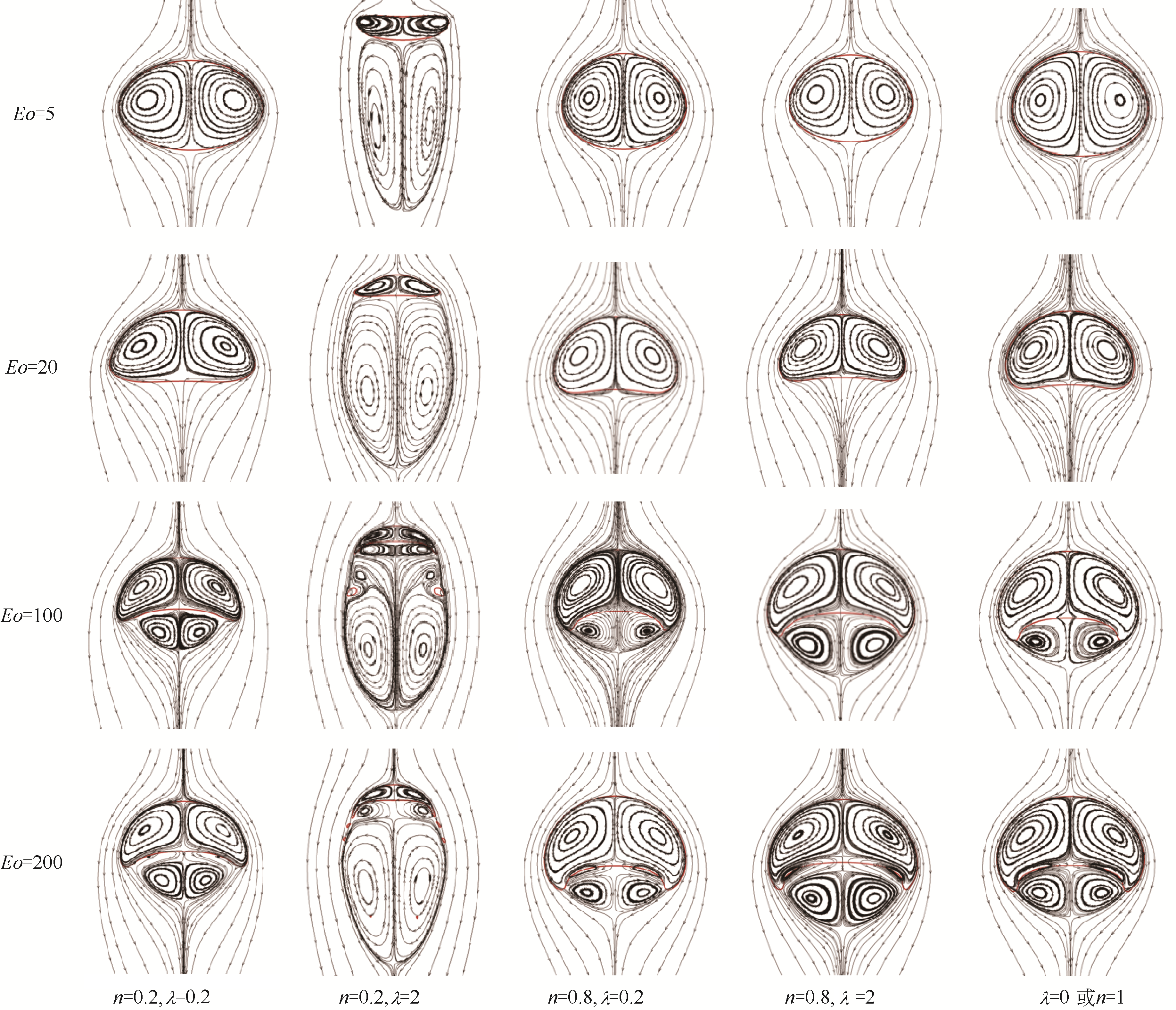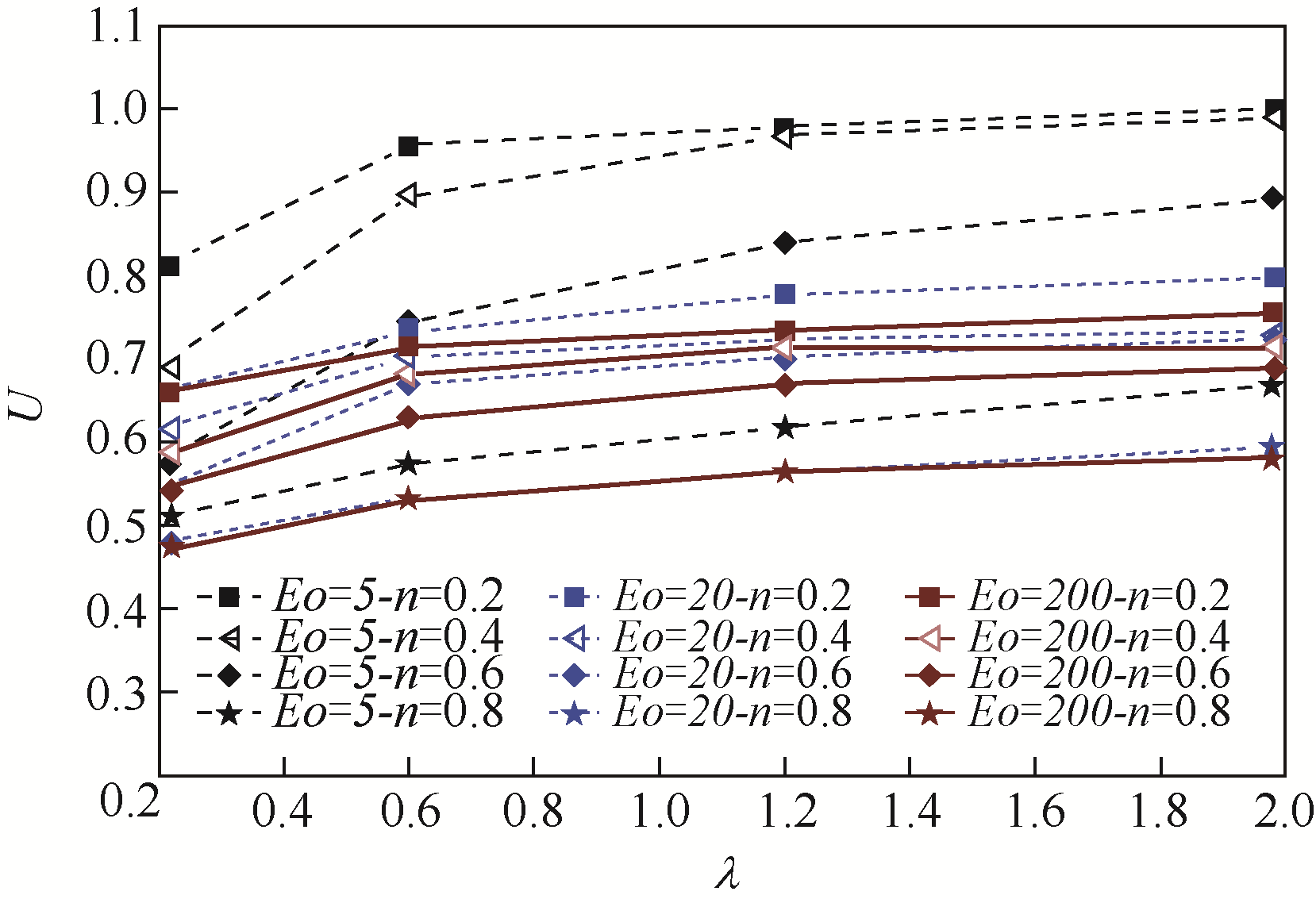Chemical Industry and Engineering Progress ›› 2021, Vol. 40 ›› Issue (5): 2440-2451.DOI: 10.16085/j.issn.1000-6613.2020-1206
• Chemical processes and equipment • Previous Articles Next Articles
Effects of characteristic time on bubble dynamic in shear thinning fluids
- Jiangsu Key Laboratory of Green Process Equipment, School of Mechanical Engineering and Rail Transit, Changzhou University, Changzhou 213164, Jiangsu, China
-
Received:2020-06-29Online:2021-05-24Published:2021-05-06 -
Contact:PANG Mingjun
特征时间对剪切稀化流体气泡上浮特性的影响
- 常州大学机械与轨道交通学院,江苏省绿色过程装备重点实验室,江苏 常州 213164
-
通讯作者:庞明军 -
作者简介:胡波(1992—),男,硕士研究生,研究方向为非牛顿流体中气泡运动特性。E-mail:983454335@qq.com 。 -
基金资助:国家自然科学基金(51376026);2020年度常州大学创新创业基金(2020-B-32)
CLC Number:
Cite this article
HU Bo, PANG Mingjun. Effects of characteristic time on bubble dynamic in shear thinning fluids[J]. Chemical Industry and Engineering Progress, 2021, 40(5): 2440-2451.
胡波, 庞明军. 特征时间对剪切稀化流体气泡上浮特性的影响[J]. 化工进展, 2021, 40(5): 2440-2451.
share this article
Add to citation manager EndNote|Ris|BibTeX
URL: https://hgjz.cip.com.cn/EN/10.16085/j.issn.1000-6613.2020-1206
| 参数 | Gumulya等[ | Premlata等[ | Ohta等[ | Tripathi等[ | 本文 |
|---|---|---|---|---|---|
| L/d | 9.3 | 10 | 4 | 24 | 25 |
| H/d | 27.9 | 45 | 20 | 10 | 40 |
| h/d | — | 2.5 | — | 2.5 | 20/3 |
| 参数 | Gumulya等[ | Premlata等[ | Ohta等[ | Tripathi等[ | 本文 |
|---|---|---|---|---|---|
| L/d | 9.3 | 10 | 4 | 24 | 25 |
| H/d | 27.9 | 45 | 20 | 10 | 40 |
| h/d | — | 2.5 | — | 2.5 | 20/3 |
| n | λ(Eo=5) | λ(Eo=20) | λ(Eo=100) | λ(Eo=200) | |||||||||||||||
|---|---|---|---|---|---|---|---|---|---|---|---|---|---|---|---|---|---|---|---|
| 0.2 | 0.6 | 1.2 | 2 | 0.2 | 0.6 | 1.2 | 2 | 0.2 | 0.6 | 1.2 | 2 | 0.2 | 0.6 | 1.2 | 2 | ||||
| 0.2 | √ | √ | √ | √ | √ | √ | √ | √ | √ | √ | √ | √ | √ | √ | √ | √ | |||
| 0.4 | √ | √ | √ | √ | √ | √ | √ | √ | √ | √ | √ | √ | √ | √ | √ | √ | |||
| 0.6 | √ | √ | √ | √ | √ | √ | √ | √ | √ | √ | √ | √ | √ | √ | √ | √ | |||
| 0.8 | √ | √ | √ | √ | √ | √ | √ | √ | √ | √ | √ | √ | √ | √ | √ | √ | |||
| n=1或λ=0 | √ | √ | √ | √ | |||||||||||||||
| n | λ(Eo=5) | λ(Eo=20) | λ(Eo=100) | λ(Eo=200) | |||||||||||||||
|---|---|---|---|---|---|---|---|---|---|---|---|---|---|---|---|---|---|---|---|
| 0.2 | 0.6 | 1.2 | 2 | 0.2 | 0.6 | 1.2 | 2 | 0.2 | 0.6 | 1.2 | 2 | 0.2 | 0.6 | 1.2 | 2 | ||||
| 0.2 | √ | √ | √ | √ | √ | √ | √ | √ | √ | √ | √ | √ | √ | √ | √ | √ | |||
| 0.4 | √ | √ | √ | √ | √ | √ | √ | √ | √ | √ | √ | √ | √ | √ | √ | √ | |||
| 0.6 | √ | √ | √ | √ | √ | √ | √ | √ | √ | √ | √ | √ | √ | √ | √ | √ | |||
| 0.8 | √ | √ | √ | √ | √ | √ | √ | √ | √ | √ | √ | √ | √ | √ | √ | √ | |||
| n=1或λ=0 | √ | √ | √ | √ | |||||||||||||||
| 液相 | d/mm | UT.exp[ | UT.cal/cm·s-1 | μ0/Pa·s | λ/s | n | Δ/% |
|---|---|---|---|---|---|---|---|
| CMC1(羧甲基纤维素) | 4.19 | 21.5 | 19.6 | 0.0377 | 0.512 | 0.89 | 8.84 |
| HEC1(羧乙基纤维素) | 2.84 | 11.88 | 13.13 | 0.047 | 0.0624 | 0.79 | 10.52 |
| 液相 | d/mm | UT.exp[ | UT.cal/cm·s-1 | μ0/Pa·s | λ/s | n | Δ/% |
|---|---|---|---|---|---|---|---|
| CMC1(羧甲基纤维素) | 4.19 | 21.5 | 19.6 | 0.0377 | 0.512 | 0.89 | 8.84 |
| HEC1(羧乙基纤维素) | 2.84 | 11.88 | 13.13 | 0.047 | 0.0624 | 0.79 | 10.52 |
| 1 | LI Shaobai, MA Youguang, FU Taotao, et al. The viscosity distribution around a rising bubble in shear-thinning non-Newtonian fluids[J]. Brazilian Journal of Chemical Engineering, 2012, 29(2): 265-274. |
| 2 | 徐艳艳, 刘伟, 舒婷, 等. 泡沫浮选耦合膜过滤回收有机废水中纳米TiO2光催化剂的工艺[J]. 化工进展, 2019, 38(10): 4773-4779. |
| XU Yanyan, LIU Wei, SHU Ting, et al. Recovery of nano-sized TiO2 photocatalyst from its organic wastewater by using a technology of froth flotation coupled with ultrafiltration[J]. Chemical Industry and Engineering Progress, 2019, 38(10): 4773-4779. | |
| 3 | TRIPATHI M K, SAHU K C, KARAPETSAS G, et al. Bubble rise dynamics in a viscoplastic material[J]. Journal of Non-Newtonian Fluid Mechanics, 2015, 222: 217-226. |
| 4 | BHAGA D, WEBER M E. Bubbles in viscous liquids: shapes, wakes and velocities[J]. Journal of Fluid Mechanics, 1981, 105: 61-85. |
| 5 | PREMLATA A R, TRIPATHI M K, KARRI B, et al. Numerical and experimental investigations of an air bubble rising in a Carreau-Yasuda shear-thinning liquid[J]. Physics of Fluids, 2017, 29(3): 033103. |
| 6 | 徐晓飞, 张菊, 刘凤霞. 非牛顿流体中单气泡运动行为的研究[J]. 力学研究, 2017, 6(1): 46-55. |
| XU Xiaofei, ZHANG Ju, LIU Fengxia. Rising behavior of single bubbles in non-Newtonian fluid[J]. International Journal of Mechanics Research, 2017, 6(1): 46-55. | |
| 7 | 陆敏杰, 庞明军. 静止幂律流体中气泡上升运动特性的数值研究[J]. 工程热物理学报, 2018, 39(11): 2454-2462. |
| LU Minjie, PANG Mingjun. Numerical study of dynamics of the single bubble rising in quiescent power-law fluid[J]. Journal of Engineering Thermophysics, 2018, 39(11): 2454-2462. | |
| 8 | PREMLATA A R, TRIPATHI M K, KARRI B, et al. Dynamics of an air bubble rising in a non-Newtonian liquid in the axisymmetric regime[J]. Journal of Non-Newtonian Fluid Mechanics, 2017, 239: 53-61. |
| 9 | 李鑫, 张攀, 陈光辉, 等. 液相中气泡上升行为与界面传质: 实验研究与数值计算[J]. 化工进展, 2019, 38(2): 740-751. |
| LI Xin, ZHANG Pan, CHEN Guanghui, et al. Rising behavior of bubbles and interfacial mass transfer in liquid: experimental study and numerical simulation[J]. Chemical Industry and Engineering Progress, 2019, 38(2): 740-751. | |
| 10 | LIU Liu, YAN Hongjie, ZHAO Guojian. Experimental studies on the shape and motion of air bubbles in viscous liquids[J]. Experimental Thermal and Fluid Science, 2015, 62: 109-121. |
| 11 | 姜韶堃, 马友光, 陶志勇. 非牛顿流体中运动气泡的形变[J]. 舰船科学技术, 2010, 32(12): 38-41. |
| JIANG Shaokun, MA Youguang, TAO Zhiyong. Deformation of moving bubble in non-Newtonian fluid[J]. Ship Science and Technology, 2010, 32(12): 38-41. | |
| 12 | LI Shaobai, YAN Zheng, LI Rundong, et al. Numerical simulation of single bubble rising in shear-thinning fluids by level set method[J]. Journal of Central South University, 2016, 23(4): 1000-1006. |
| 13 | VAHABI M, SADEGHY K. Simulating bubble shape during its rise in Carreau-Yasuda fluids using WC-SPH method[J]. The Society of Rheology, Japan, 2014, 41(5): 319-329. |
| 14 | 张菊. 非牛顿流体中气泡行为及其周围流场特性研究[D]. 大连: 大连理工大学, 2016. |
| ZHANG Ju. The study of bubble behaviors and ambient flow field in non-Newtonian fluid[D]. Dalian: Dalian University of Technology, 2016. | |
| 15 | OSHAGHI M R, AFSHIN H, FIROOZABADI B. Investigation of bubble formation and its detachment in shear-thinning liquids at low capillary and bond numbers[J]. Theoretical and Computational Fluid Dynamics, 2019, 33(5): 463-480. |
| 16 | GOLLAKOTA A R K, KISHORE N. CFD study on rise and deformation characteristics of buoyancy-driven spheroid bubbles in stagnant Carreau model non-Newtonian fluids[J]. Theoretical and Computational Fluid Dynamics, 2018, 32: 35-46. |
| 17 | OHTA M, KIMURA S, FURUKAWA T, et al. Numerical simulations of a bubble rising through a shear-thickening fluid[J]. Journal of Chemical Engineering of Japan, 2012, 45(9): 713-720. |
| 18 | SIKORSKI D, TABUTEAU H, DE BRUYN J R. Motion and shape of bubbles rising through a yield-stress fluid[J]. Journal of Non-Newtonian Fluid Mechanics, 2009, 159 (1/2/3): 10-16. |
| 19 | GUMULYA M, JOSHI J B, UTIKAR R P, et al. Bubbles in viscous liquids: time dependent behaviour and wake characteristics[J]. Chemical Engineering Science, 2016, 144: 298-309. |
| 20 | 戴得志. 基于VOF方法的气-液两相流动的数值计算[D]. 南京: 南京航空航天大学, 2014. |
| DAI Dezhi. Numerical simulation of gas-liquid two-phase flow based on VOF method[D]. Nanjing: Nanjing University of Aeronautics and Astronautics, 2014. | |
| 21 | YOUNGS D L. Time-dependent multi-material flow with large fluid distortion[M]//MORTON K W, BAINES M J. Numerical methods for fluid dynamics. New York: Academic Press, 1982: 273-285. |
| 22 | 赵大勇, 李维仲. VOF 方法中几种界面重构技术的比较[J]. 热科学与技术, 2003, 2(4): 318-323. |
| ZHAO Dayong, LI Weizhong. Comprison of three kinds of interface reconstruction methods applied to VOF[J]. Journal of Thermal Science and Technology, 2003, 2(4): 318-323. | |
| 23 | PANG Mingjun, LU Minjie. Numerical study on dynamics of single bubble rising in shear-thinning power-law fluid in different gravity environment[J]. Vacuum, 2018, 153: 101-111. |
| 24 | BRACKBILL J U, KOTHE D B, ZEMACH C. A continuum method for modeling surface tension[J]. Journal of Computational Physics, 1992, 100(2): 335-354. |
| 25 | ZHANG Li, YANG Chao, MAO Zaisha. Numerical simulation of a bubble rising in shear-thinning fluids[J]. Journal of Non-Newtonian Fluid Mechanics, 2010, 165: 555-567. |
| 26 | 倪明玖. 浮力作用下上升气泡的变形和驻涡形成机理研究[J]. 工程热物理学报, 2009, 30(1): 76-80. |
| NI Mingjiu. Bubble rising driven by buoyancy with deformation and standing vortex[J]. Journal of Engineering Thermophysics, 2009, 30(1): 76-80. | |
| 27 | 瞿志超, 张俊生, 陈葳. 剪切流场中高分子链构象转变的FRET研究[J]. 南京大学学报(自然科学), 2019, 55(5): 819-824. |
| QU Zhichao, ZHANG Junsheng, CHEN Wei. The conformational transitions of polymer chains in shear flow measured by FRET[J]. Journal of Nanjing University (Natural Science), 2019, 55(5): 819-824. | |
| 28 | 陈晓明, 张璟焱, 徐文总, 等. 关于高分子液体“高黏度”和“剪切变稀”的讨论[J]. 高分子通报, 2019(6): 68-71. |
| CHEN Xiaoming, ZHANG Jingyan, XU Wenzong, et al. Discussion on “high viscosity” and “shear thinning” of polymer liquids[J]. Polymer Bulletin, 2019(6): 68-71. | |
| 29 | BATTISTELLA A, SCHIJNDEL S J G VAN, BALTUSSEN M W, et al. On the terminal velocity of single bubbles rising in non-Newtonian power-law liquids[J]. Journal of Non-Newtonian Fluid Mechanics, 2020, 278: 104249. |
| [1] | CHEN Kuangyin, LI Ruilan, TONG Yang, SHEN Jianhua. Structure design of gas diffusion layer in proton exchange membrane fuel cell [J]. Chemical Industry and Engineering Progress, 2023, 42(S1): 246-259. |
| [2] | ZHAO Chen, MIAO Tianze, ZHANG Chaoyang, HONG Fangjun, WANG Dahai. Heat transfer characteristics of ethylene glycol aqueous solution in slit channel under negative pressure [J]. Chemical Industry and Engineering Progress, 2023, 42(S1): 148-157. |
| [3] | BU Zhicheng, JIAO Bo, LIN Haihua, SUN Hongyuan. Review on computational fluid dynamics (CFD) simulation and advances in pulsating heat pipes [J]. Chemical Industry and Engineering Progress, 2023, 42(8): 4167-4181. |
| [4] | CHEN Weiyang, SONG Xin, YIN Yaran, ZHANG Xianming, ZHU Chunying, FU Taotao, MA Youguang. Effect of liquid viscosity on bubble interface in the rectangular microchannel [J]. Chemical Industry and Engineering Progress, 2023, 42(7): 3468-3477. |
| [5] | LIU Houli, GU Zhonghao, YANG Kang, ZHANG Li. Effect of groove width on pool boiling heat transfer characteristics in 3D printing groove structure [J]. Chemical Industry and Engineering Progress, 2023, 42(5): 2282-2288. |
| [6] | PANG Liping, YUAN Hu, QIU Wensheng, DUAN Liqiang, LI Wenxue. Hydrodynamic characteristics during peaking operation in utility boiler [J]. Chemical Industry and Engineering Progress, 2023, 42(4): 1708-1718. |
| [7] | ZHANG Meng, LI Shuqian, ZHANG Dong, MA Kunru. Motion characteristics for vapor-liquid interfaces of direct contact condensation in a microchannel [J]. Chemical Industry and Engineering Progress, 2022, 41(9): 4644-4652. |
| [8] | MEI Xiang, YAO Yuanpeng, WU Huiying. Analysis of heat transfer enhancement mechanism on subcooled flow boiling in interconnected microchannels [J]. Chemical Industry and Engineering Progress, 2022, 41(6): 2884-2892. |
| [9] | QIAN Yuanyuan, WANG Yongjie, YANG Xuejing. Application of ozone for water treatment and implication of mass transfer characteristics [J]. Chemical Industry and Engineering Progress, 2021, 40(S1): 411-425. |
| [10] | LIAO Peiyi, YANG Daijun, MING Pingwen, XUE Mingzhe, LI Bing, ZHANG Cunman. Research progress of gas-liquid two-phase flow in micro-channel and its application in PEMFC [J]. Chemical Industry and Engineering Progress, 2021, 40(9): 4734-4748. |
| [11] | WU Hao, SUO Mengshan, TAO Xingxiao, CHE Zhizhao, SUN Kai, CHEN Rui, WANG Tianyou. Optical visualization of gas-liquid two-phase flow in open-cell metal foam [J]. Chemical Industry and Engineering Progress, 2021, 40(8): 4152-4164. |
| [12] | ZHAO Ning, JIA Huijun, GUO Liqiang, LIU Yuhang, FANG Lide. Measurement method and analysis of droplet entrainment in annular flow [J]. Chemical Industry and Engineering Progress, 2021, 40(12): 6469-6478. |
| [13] | REN Siyuan, LIU Chunjiang, GUO Kai, LIU Hui, XIANG Wenyu, XIE Chungang, LI Xue. Experiments and simulation of hydraulic jump of non-central impinging jet on rotating disk [J]. Chemical Industry and Engineering Progress, 2021, 40(11): 6027-6034. |
| [14] | Yibin LI, Kaiyi LIANG, Xiaohui DAI, Zhenggui LI. Numerical simulation of eddy effect in the mixing process of gas-liquid two-phase flow in stirred reactor [J]. Chemical Industry and Engineering Progress, 2021, 40(1): 99-110. |
| [15] | Shiwang LI, Shibo WANG, Hua WANG, Yuhui WANG, Quankun CHEN. Numerical simulation and strengthening mechanism analysis of multi-channel bottom-blowing spray lance stirring [J]. Chemical Industry and Engineering Progress, 2020, 39(9): 3563-3573. |
| Viewed | ||||||
|
Full text |
|
|||||
|
Abstract |
|
|||||

